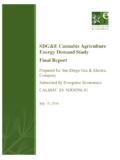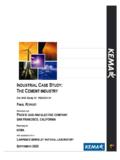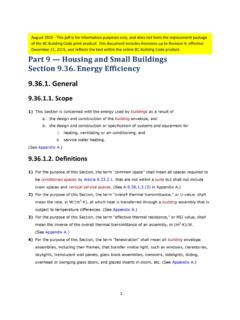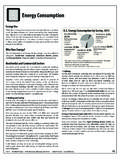Transcription of HVAC Energy Efficiency Maintenance Study - …
1 hvac Energy Efficiency Maintenance Study Issued: December 29, 2010. Presented To: Brett Close Southern California Edison Prepared By: Marshall Hunt, PE, Davis Energy Group, Inc. Kristin Heinemeier, PhD, PE, UC Davis, WCEC. Marc Hoeschele, PE, Davis Energy Group, Inc Elizabeth Weitzel, Davis Energy Group, Inc. CALMAC Study ID 2010 Davis Energy Group, Inc. All rights reserved. Acknowledgements The authors would like to thank Brett Close of the SCE for his valuable insights, support and facilitation of the project process, and project management. We would like to acknowledge the assistance of the Project Management Team, our Project Advisory Panel, and attendees of our Technical Forum. Finally, the report benefited from detailed comments on the review draft by experts in the field who took the time to delve into the details of the report calculations and analysis. We had significant help on this report from Jennifer White and Campbell BrownKorbel.
2 hvac Energy Efficiency Maintenance Study Executive Summary Research has shown that the performance of existing residential and small-commercial heating ventilating and air-conditioning ( hvac ) systems is far from optimal. In many cases, the systems were never installed correctly and have never operated optimally, resulting in lower Efficiency than implied by the nameplate rating. In other cases, the performance has degraded over time, either because of faults or improper service, causing the equipment to malfunction or to perform poorly. Measures such as duct sealing and repair, condenser and evaporator coil cleaning, refrigerant charge and air flow adjustments, economizer retro-commissioning, and hvac controls can potentially produce significant savings. The California investor-owned utilities (IOUs) have shown a great deal of leadership in initiating Maintenance -based hvac programs. These and other Energy Efficiency programs have been in existence since the 1980s, and have reached millions of homes and small businesses.
3 Despite their success in reaching the market, however, the Energy savings attributable to hvac . Maintenance programs have been called into question. For example, one evaluation of savings for residential charge and air-flow adjustment programs in the 2006-2008 program cycle found quite low savings rates, but also found wide variations in the different program impact parameters. These studies raised the possibility that some of the Evaluation, Measurement and Verification (EM&V) questions being asked and answered have such large uncertainties that conclusions and recommendations based on them should be considered carefully. In the long run, achieving the ambitious California Public Utilities Commission (CPUC) Big- Bold hvac goal of 50% improvement in residential and small commercial hvac system Efficiency will require new, more comprehensive programs that have the potential for greater impact.
4 For these programs to constitute a prudent use of ratepayer money, however, they must be designed based on a good understanding of the impacts and interrelationships of individual and combined system faults ( , abnormal conditions that may lead to system performance degradation or failure) and Maintenance measures. A simple widgets approach that focuses on individual measures that save 10% here and 5% there will not achieve the level of savings that is needed to meet the CPUC's ambitious goal. hvac technologies should benefit from a broad based systems approach. Highlights of our analysis include the following key observations, each of which is discussed in depth in the report. Uncertainties are inherent in programs such as these and are not well accounted for. There are many interrelated sources of uncertainty, including measurement errors, uncertainties in predicting human behavior, and the compounding effect of performing calculations on imperfect data.
5 Perhaps the most important observation here is that, with the program specifications, methods, and tools commonly used today, it is difficult for a simple refrigerant charge adjustment to be implemented, measured, and verified to the level of confidence that is required by the CPUC. It is impossible to eliminate all sources of uncertainty, but they should be mitigated where possible ( if the technician stops when a target superheat or subcooling value is reached there will be a 50% chance that the charge will be within the desired range, and a 50%. Davis Energy Group, Inc. Page E-1 December 29, 2010. hvac Energy Efficiency Maintenance Study chance that it will not). A good understanding of uncertainties by program designers, contractors, and technicians is important. Additional screening and more sophisticated diagnostic/servicing approaches would benefit future programs. Quality Maintenance programs have the potential to be successful, but their design and structure could be improved.
6 For example, if technicians perform basic screening of hvac systems to determine whether (and which) services are likely to improve Efficiency before implementing charge adjustments, additional Energy could be saved. Furthermore, implementing multiple measures can potentially save much more Energy than the current strategy of implementing single, simple measures, particularly when multiple faults are present. The costs of providing such a comprehensive service may be higher. However, the additional savings might justify the cost at a large number of sites. The presence of multiple faults and the need for multiple measures complicates diagnostic/service protocols in ways that are not well understood. There is not a thorough, up to date, and independent assessment of the baseline fault conditions of the over 10 million unitary air conditioners in California. Further Study would help to develop appropriate diagnostic and service strategies that can be guided by the principles of making sure that no harm is done to the system, that Energy Efficiency is improved, and that to the greatest extent possible every site visit results in an Energy Efficiency improvement.
7 Human factors are significant but are poorly understood. The behavior, motivations, preparation, and constraints on technicians, owners, tenants, contractors, and EM&V specialists can make or break a program. This is an area that has been overlooked in the field of behavioral research, and a better understanding of why people do what they do is critical. If broad CPUC. Energy Efficiency policy goals are to be achieved, the measurement of "free-ridership" needs to be improved to recognize that hvac quality Maintenance measures and services do not exist without the support of Energy Efficiency programs. Measurement and verification processes must be improved. EM&V processes and instrumentation need to be improved and integrated with program delivery, quality control and reporting. One-time field EER measurements appear to be of marginal value since uncertainties can approach 20%. Even with high-quality, time-series EER measurements, there is uncertainty in simulating the annual kWh savings, in part due to behavioral factors affecting occupancy and thermostat patterns.
8 Longer term, broadly implemented pre- and post- measurements of kWh consumption would reduce uncertainty, and could be implemented using utility smart meters and/or web based sub metering. Over the long term, achieving large Energy savings might be possible with replacement of existing systems and integration with whole-building Energy Efficiency measures. Intuitively, the whole-building approach to Energy Efficiency should be much more effective than implementing Energy Efficiency measures in a piecemeal fashion, with the potential to achieve savings of over 50%. Past attempts at this approach have enjoyed limited success. The theory is that a new hvac system can be sized for the reduced load that results from improvements in ducts, windows, insulation, lighting, infiltration, etc. Equipment kW savings are achieved, although kWh savings are less certain. In the long term, the hvac industry and utility Energy Efficiency programs will continue to improve and will likely include providing quality installation, commissioning, automated diagnostics, demand response, and whole- Davis Energy Group, Inc.
9 Page E-2 December 29, 2010. hvac Energy Efficiency Maintenance Study building integration, in addition to Maintenance . There will probably always be a need for Maintenance -based programs to address the hvac systems that can become efficient when they receive quality Maintenance and the repairs that are needed. In the short run, the authors feel that Maintenance -based programs continue to be refined, improved, and redesigned. The focus of this Study is on how the industry can be moved from current programs to better programs in the future. This project was sponsored by Southern California Edison (SCE), Pacific Gas and Electric (PG&E), San Diego Gas and Electric (SDG&E) and Southern California Gas (SCG) EM&V funds and managed by SCE to evaluate the current state of knowledge on the impact of hvac Maintenance measures, analyze potential sources of uncertainties, and develop recommendations for additional research.
10 We hope this report will provide a common framework for discussion and facilitate better communication among program stakeholders, while providing insight into potential areas for improvement. Davis Energy Group, Inc. Page E-3 December 29, 2010. hvac Energy Efficiency Maintenance Study Table of Contents Executive Summary ..E-1 1 Introduction .. 1 2 Project Objectives .. 5 3 Methodology .. 6 4 Refrigeration Cycle Analysis and RCA 8 5 Duct Systems and DTS Programs .. 18 6 EER, Energy Savings, and Peak Demand Reduction .. 24 7 Uncertainties in Site 32 8 Uncertainties in kWh Calculations .. 43 9 Other Uncertainties .. 45 10 Implications of Uncertainty .. 53 11 Roadmap to CPUC Goals .. 59 12 Research Plan .. 63 13 Conclusions and Recommendations .. 69 14 References .. 73 Glossary .. 77 Tables Table 1. Example R-22 Superheat Calculation ..16. Table 2. Data for Sensitivity Coefficient Calculations.









